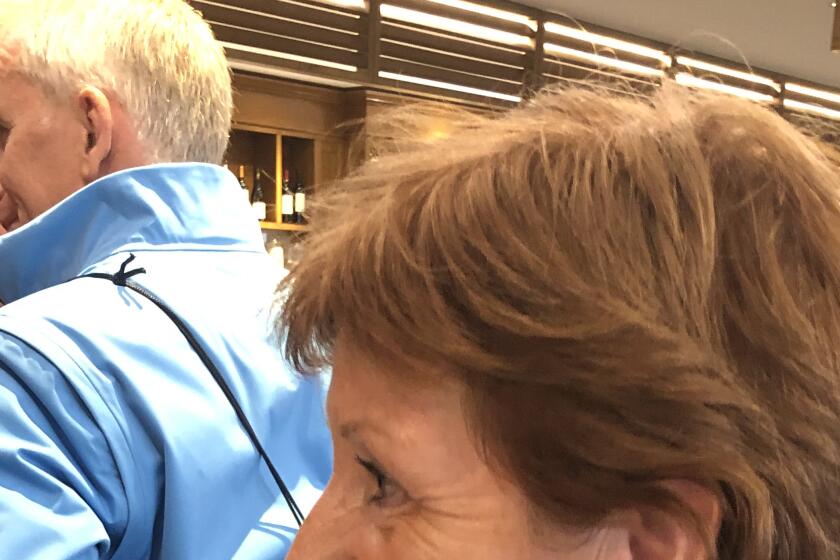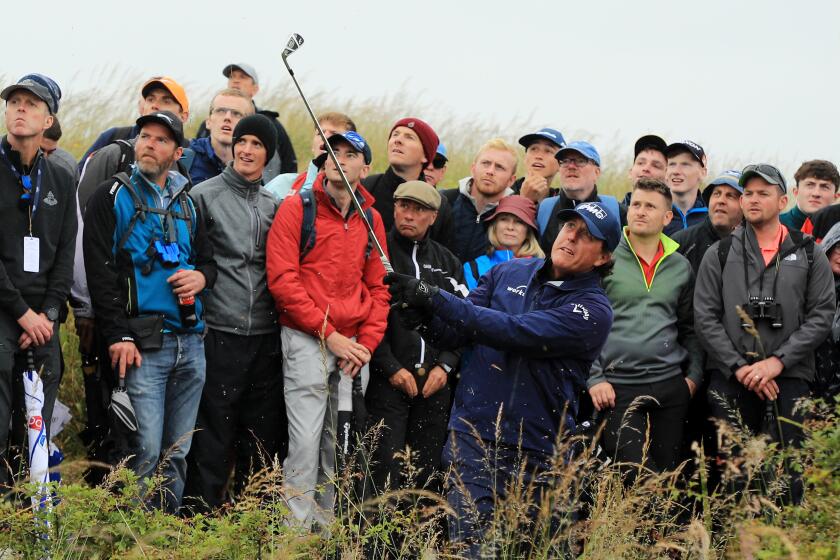British Open: These daring photographers get the shot from a God’s-eye view
- Share via
PORTRUSH, Northern Ireland — The British Open is what’s happening far below. For the bold camera operators who stand on tiny circular platforms atop 20-story cranes, it’s the wide, wide open.
The cranes are like thin arms reaching into the roiling skies and swaying with the gusting winds.
“It can get pretty hairy sometimes,” said Mark McCafferty, who has shot sports footage from the tip of the matchsticks for more than 20 years. “The worst thing is when it’s windy and rainy. When the rain’s in your face, it feels a bit like a bag of rice, just throwing it at your face constantly. So if you’re up there for a few hours it can be very uncomfortable.”
These camera operators, all men from Britain at this major championship, get extra pay, and for good reason. It’s not a job for the meek, especially when storms can roll in at any minute. The 10 cranes strategically placed around Royal Portrush — five manned, five fitted with radio-controlled cameras — are all raised to roughly 150 feet but can be extended to 250.
“Sometimes, when you’re looking down on the truck that’s holding the boom, it looks like a small toy, like a Matchbox car,” McCafferty said. “It doesn’t make sense to your brain, really. It doesn’t look right.”
It’s all about getting the shot from a God’s-eye view, watching Tiger Woods hit his drive, then tracking the arc of the ball as it makes its way toward the target.
“I love [the high camera angles], because they’re such a unique perspective,” said Dave White, who is coordinating camera logistics for the tournament. “What I really love about them is you see so much going on that nobody else sees. You see the boats out in the harbors. You see people playing five-side [soccer] out in the park. There’s always so much going on.
“The shots of the ball follows they get in golf are incredible. You can see the whole thing; there are no restrictions. You really get a geographical sense of where it is, because they follow the ball a lot wider.”
Wilma Erskine is stepping down this fall after 34 years of running Royal Portrush. She was key in bringing the British Open back to Northern Ireland.
Cameras on the ground are tracking a white ball against a white or light sky, so they need to be zoomed in on the ball. The cranes look down on the ball, so the backdrop is green. Therefore, it’s easier to see the ball from a wider angle.
People shooting from atop the cranes wear harnesses, and are ringed by railings called a cage or basket. Each platform is fitted with an anemometer, which measures wind speed, and an alarm sounds if the speeds reach 30 mph. The crane can be lowered in as little as two minutes, although that would be a brisk, rough ride.
Lightning is the biggest concern. There’s someone at the tournament assigned to monitor the local weather and keep a keen eye on any approaching lightning activity. In that case, everyone comes down from the cranes. Everyone involved also has a phone app that keeps track of any lightning storms nearby.
The cranes aren’t just used for golf, but for all types of sporting events, including high-profile cricket matches, motor racing, horse races and marathons. There are several women operators who shoot sports action from cranes, but not many, if any, who work golf.
“It’s a way of putting in a camera position quickly, for instance, when they close a road, rather than building a tower that would take five or six hours,” White said. “You can hoist a camera in half an hour.”
The circular baskets are about 8 feet in diameter and are built to hold one person and equipment. They can be manually rotated like a Lazy Susan almost the whole way around.
Day 2 of the 148th British Open in Portrush, Nothern Ireland
“The operators are not only panning the cameras, but they’re panning the buckets,” White said. “So as they’re going around, they’re taking their hand off the focus and then pulling the cage around, then hand back up to the focus.”
Each hoist costs roughly $1.25 million and is outfitted with six computers that can be accessed remotely by technicians. If one of those six sensors detects an irregularity, the basket is grounded.
“With us, we know these machines like the back of our hand,” said crane operator Malcolm Phillips, who also does industrial jobs with bigger baskets that can accommodate multiple people.
“We have full confidence in the manufacturers who build them, the engineers who look after them for us. When you have full confidence like that, you go up there with any customer who’s there with you, and you sort of pass that confidence on to them.”
That doesn’t guarantee the customer won’t be petrified.
“The majority of people are OK as long as they have something around them, as in a building in front of them,” Phillips said. “The moment you take them above the building, you’ve got some people who will immediately lose their nerve. You’ll notice their knuckles will start going white; they’re gripping more firmly onto the cage.
“Some people collapse in a hysterical heap in the corner. Some people put you in a bear hug — I’ve had that done to me — different people react in different ways. Some of them are big burly guys. People who do roof repairs can be some of the worst ones. They’re OK if they’re on the roof. But once they’re in one of these, they have not got control, we have. So once someone else is in control, they lose their nerve.”
Although White’s job mostly keeps him on the ground these days, he has worked as a crane cameraman as well.
David Duval shot a 20-over-par 91 at the British Open. He shot a 14 on No. 7, the highest score on a hole at the British Open since at least 1983.
“My wife wouldn’t even go up in the scaffold tower,” he said. “My friends think I’m mad for going up there. A lot of cameramen think you’re mad to go up. It’s very much an option.”
McCafferty has a compelling counterpoint.
“If you get a really nice day, like last week in Scotland, the weather was pretty good, it’s great,” he said. “We were on a beautiful part just east of Edinburgh. The view was fantastic. There were dolphins in the bay, all these lighthouses on islands in the distance.
“Sometimes I take my own camera up to take stills. If it’s not windy, it’s quite peaceful.”
The sentiment of many, including a lot of his friends: He can keep it.
More to Read
Go beyond the scoreboard
Get the latest on L.A.'s teams in the daily Sports Report newsletter.
You may occasionally receive promotional content from the Los Angeles Times.














